Identifying Common Lawn Weeds with Purple Flowers: A Comprehensive Guide
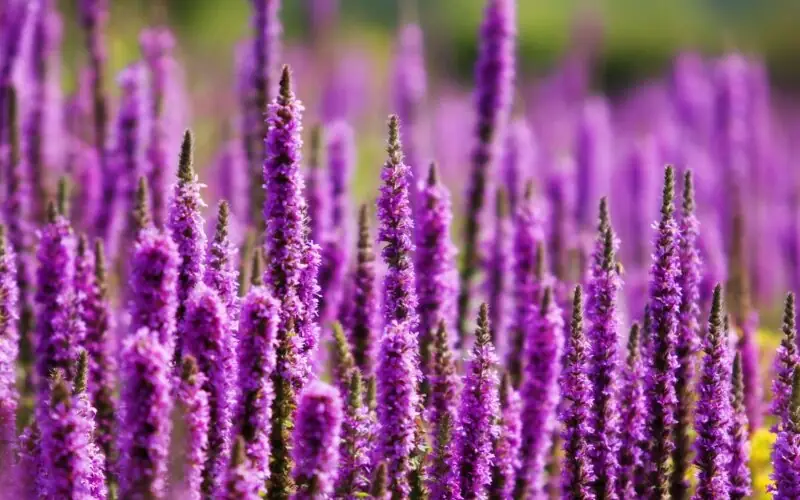
Hello, everyone! If you’re like me, you take great pride in maintaining a beautiful lawn. You spend hours mowing, fertilizing, and watering to keep it green and lush. But sometimes, pesky weeds with purple flowers just won’t leave us alone!
Today, we’re going to focus on this particular group of weeds – the ones with purple flowers. These troublesome plants can be quite tricky to identify and control properly. But fear not! By the end of this guide, you’ll be able to spot them from a mile away.
A Closer Look at Common Weeds with Purple Flowers
Let’s take a closer look at some of the most common types of weeds with pretty purple flowers that might be taking over your lawn or garden. Don’t worry, we’ll identify them and give you tips on how to control them so they don’t ruin your picture-perfect landscape.
Wild Violets (Viola sororia)
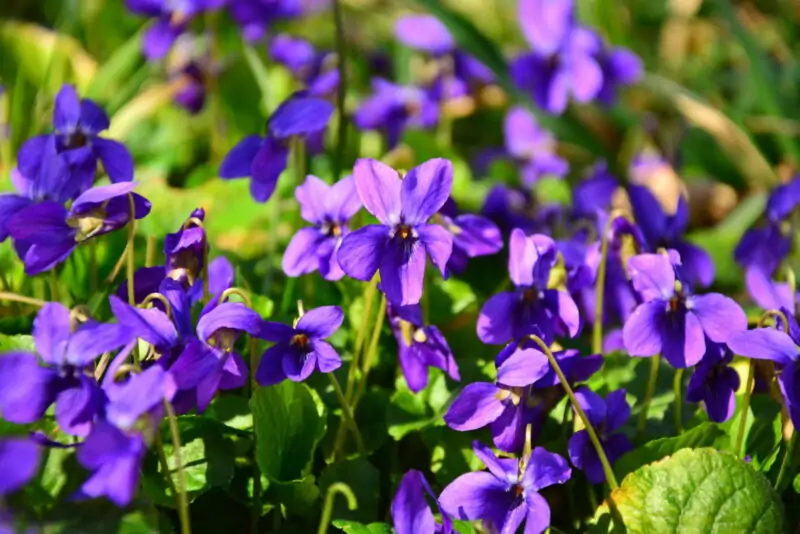
First up, we have wild violets! These little beauties are part of the Viola family and can grow up to 6 inches tall. They’re known for their heart-shaped leaves and vibrant violet petals that bloom from April to June.
But let me tell you, these fellas can quickly take over your lawn if left uncontrolled. Their underground stems called rhizomes allow them to spread rapidly, making it difficult to get rid of them entirely. The best way is through diligent hand-pulling or using an herbicide specifically designed for broadleaf weeds.
Creeping Charlie/Ground Ivy (Glechoma hederacea)
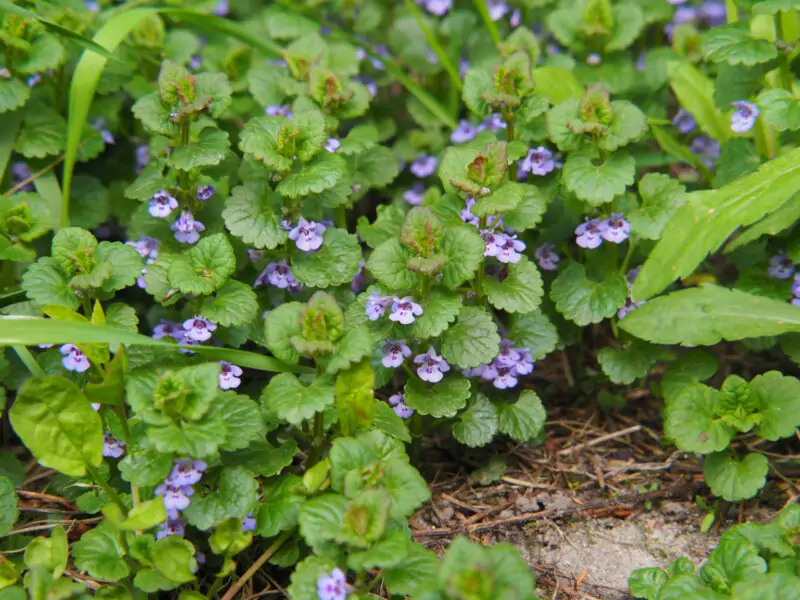
Next on our list is creeping charlie or ground ivy – whichever name you prefer! Like many weeds, this mint-family member loves moist soil and shady areas but will also grow in sunny spots too. Its small purple flowers bloom from March until May, giving off a delightful aroma that pollinators love!
However, this aggressive weed spreads by above-ground runners called stolons which attach themselves firmly into the earth, making it hard to pull out by hand alone. Your best way to get rid is using a selective herbicide made just for creeping charlie, like Triclopyr-based products, during its active growth phase in late spring-early fall when it’s actively growing.
Forget-Me-Nots (Myosotis spp.)
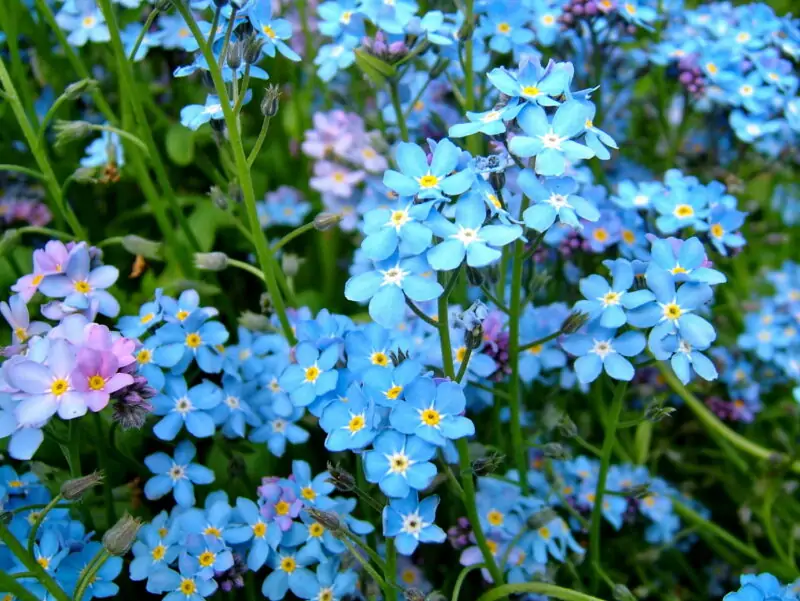
Forget-me-nots may sound romantic, but let me tell you – these guys are sneaky! They’re a small, creeping weed that can grow anywhere from 6 inches to a foot tall with lovely purple-blue flowers. The problem is they spread like wildfire by self-seeding, making them hard to control.
Their delicate stems and leaves make it easy for them to blend in with other plants, so you might not even notice them until it’s too late. Hand-pulling works well, but be sure not to let any of the seeds drop or else you’ll have more problems than before!
Black Nightshade (Solanum nigrum)
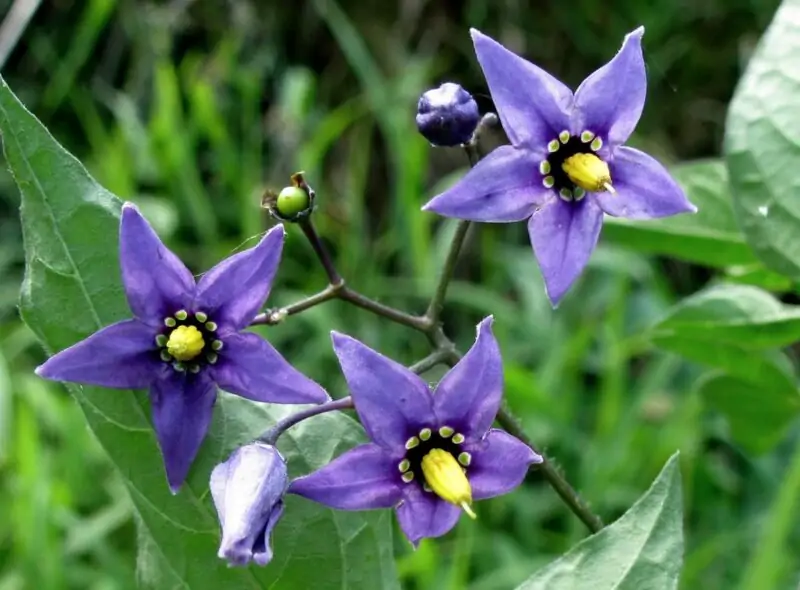
Black nightshade may look innocent enough with its pretty little purple flowers and five-pointed star shape, but don’t be fooled – it’s toxic! This little guy loves disturbed soil such as gardens or along roadsides where there’s plenty of sun.
It grows up to 4 feet tall and has dark green oval-shaped leaves that are almost waxy-looking. Its berries turn from green to black when ripe, which makes it easy for birds and animals to snack on them, spreading seeds all over your garden or lawn. Your best bet? Wear gloves while hand-pulling these sneaky fellas out!
Canada Thistle/Creeping Thistle (Cirsium arvense)
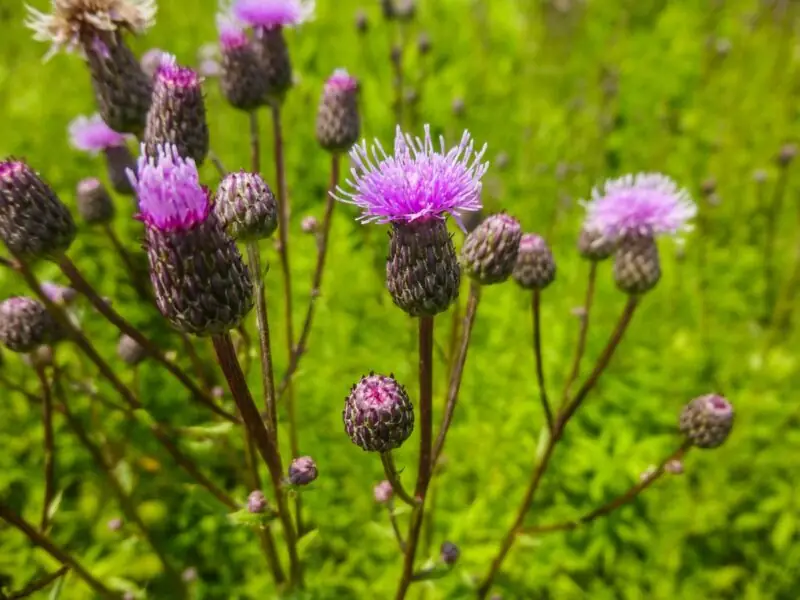
Canada thistles also go by another name – creeping thistle – because they creep their way into your lawn undetected until those pretty lilac-colored blooms start showing up all over the place! These bad boys grow up to 5 feet tall with deep taproots that make removal difficult unless done just right.
Your best bet? Wait until fall after the blooming season is over, then use an herbicide specifically formulated for thistles containing Glyphosate + Dicamba mixed together, which will kill off any remaining roots still hiding underground, readying itself for next year’s invasion.
Musk Thistle/Nodding Thistle (Carduus nutans)
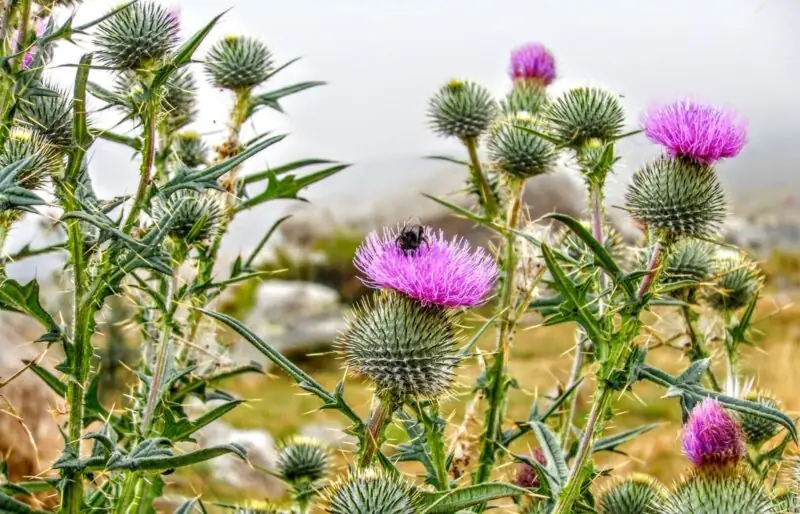
Musk thistles, also known as nodding thistle, have a unique drooping appearance and release a musky odor that pollinators adore! They can grow up to 6 feet tall with spiky leaves and lovely purple flowers that bloom from June through August.
Their deep roots make it difficult to remove them by hand. Your best bet? Use a glyphosate-based herbicide specifically designed for broadleaf weeds like Musk Thistle during the summer months when they’re actively growing.
Common Thistle/Spear Thistle/Bull Thistle (Cirsium vulgare)
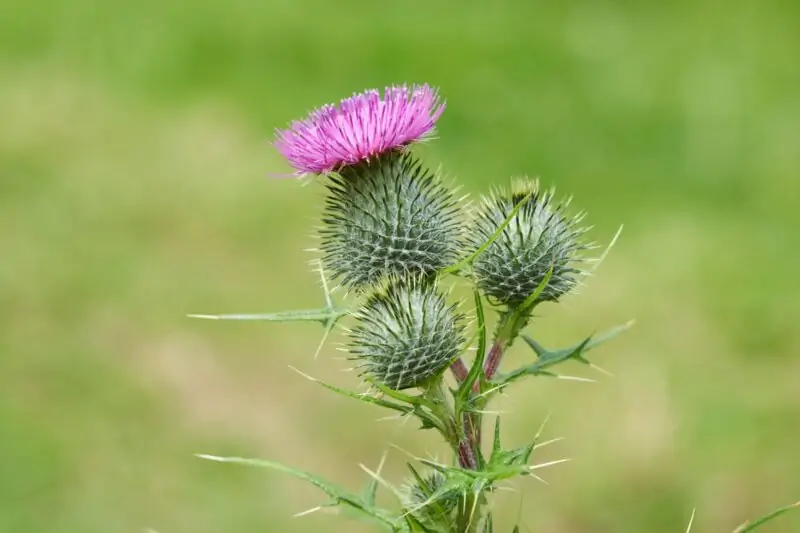
Common thistles can take over your lawn or garden in no time – trust me on this one! They grow up to 5 feet tall with prickly dark-green leaves and purple flowers that bloom all summer long.
Their underground rhizomes firmly attach themselves to the earth, making removal difficult. Your best bet? Wait until fall, then use an herbicide containing triclopyr-amine and picloram mixed together, which will kill any remaining roots still hiding underground.
Purple Dead Nettle (Lamium purpureum)
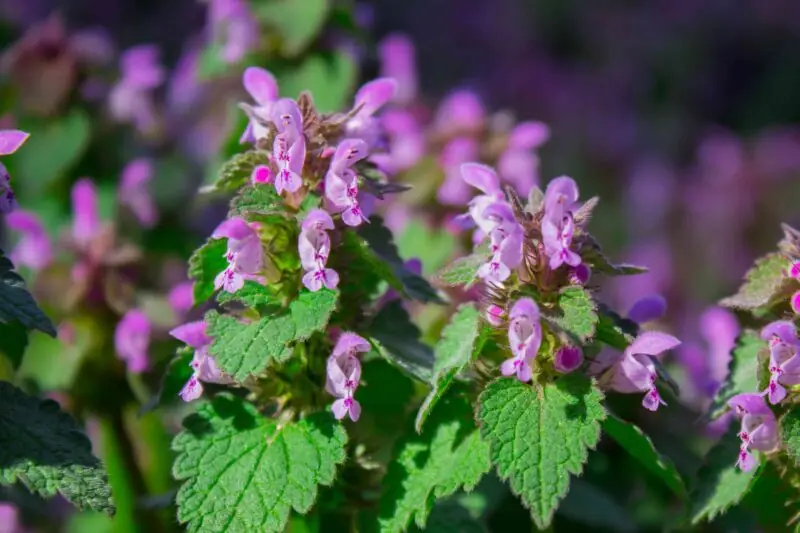
Purple dead nettles might sound scary, but don’t worry – they won’t sting you! They’re part of the mint family, meaning their stems give off a pleasant aroma while their tiny lavender-purple blooms attract plenty of pollinators!
These sneaky plants spread quickly via above-ground runners called stolons, which firmly attach themselves to the ground. Your best bet? Use non-selective contact herbicides like glufosinate-ammonium during its active growth phase in late spring to early fall.
Henbit (Lamium amplexicaule)
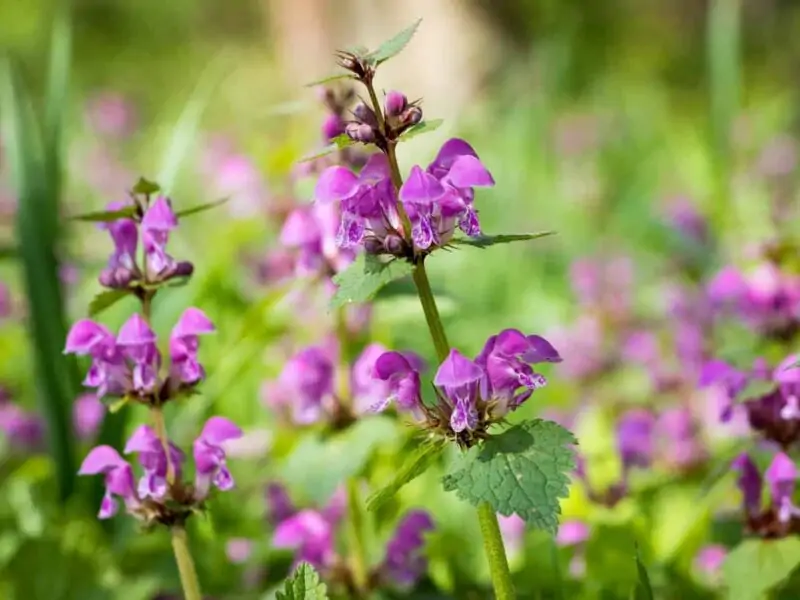
Another weed with purple flowers is henbit, also known as Lamium amplexicaule. This weed is part of the mint family and produces small, delicate purple flowers from March to May. You might mistake it for its close cousin, purple dead nettle, but henbit has more rounded leaves.
This pesky plant spreads quickly through seeds and roots, so make sure to remove it before it takes over your entire lawn! One fun fact about henbit is that its young leaves are edible – they have a mild flavor similar to spinach.
Dove’s-Foot Crane’s-Bill (Geranium molle)
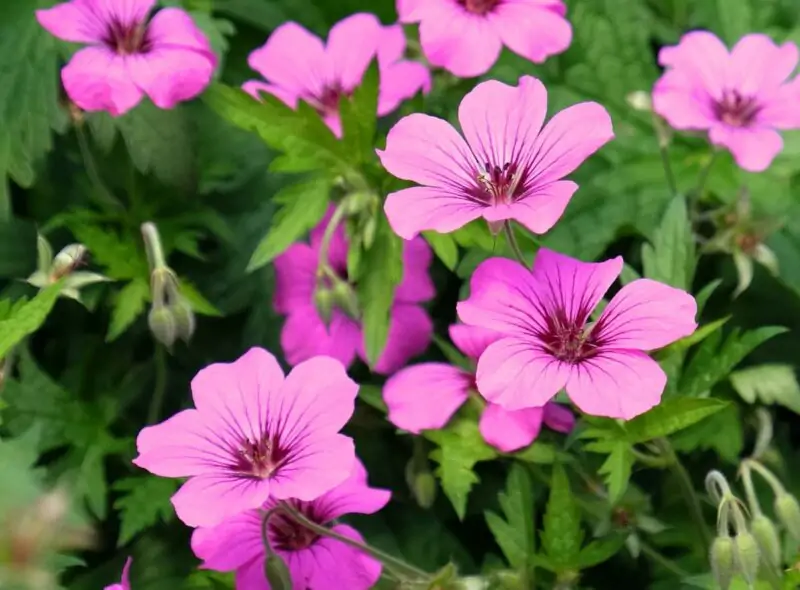
Next up is Dove’s-foot crane’s-bill, or Geranium molle, which sounds more like an exotic bird than a weed! This one has clusters of small pinkish-purple flowers with five petals each that bloom from May to August.
It grows flat along the ground, creeping around areas where other plants cannot thrive, such as cracks between paving stones or rocky terrain. The dove-foot crane’s bill gets its name because, when viewed upside down, it resembles tiny cranes dangling off long stems.
Selfheal/Healall (Prunella vulgaris)
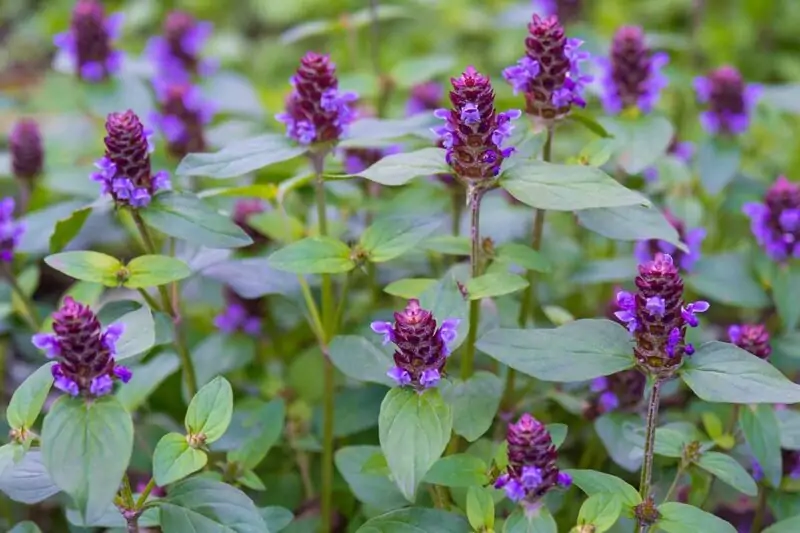
Selfheal, or Prunella vulgaris, might not be a weed many people recognize, but it’s common in lawns and gardens from June to September. The plant produces small purple flowers that grow close to the stem with tiny pink or white spots.
This little guy gets its name because of its medicinal properties – it was often used as a remedy for wounds and sore throats! It’s also known as “heal-all” due to these traditional uses.
Fun fact: Selfheal is thought to have magical powers – some say witches used it in their spells!
Violet Woodsorrel (Oxalis violacea)
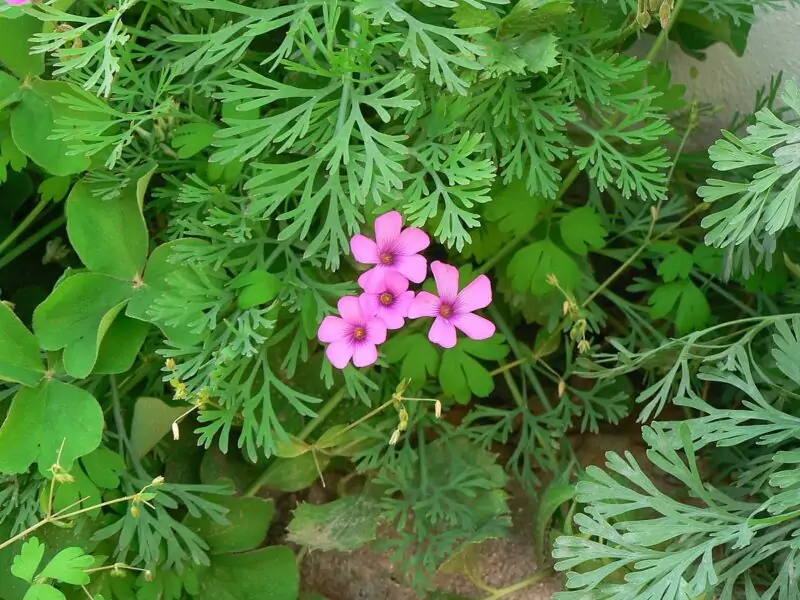
Violet woodsorrel, or Oxalis violacea, might be one of the prettiest weeds we’ll discuss today. This plant has bright purple flowers that bloom from late spring through summer, attracting bees and other pollinators!
But don’t let those vibrant colors fool you – this little guy can take over your lawn if left unchecked. It spreads quickly through underground stems called rhizomes, making it difficult to control.
One unique thing about violet woodsorrel is that all parts of the plant are edible – including the leaves, which have a tangy lemon flavor! So next time you’re out weeding your garden, consider adding some violet woodsorrel leaves into your salad for an extra zing.
Spotted Knapweed (Centaurea stoebe)
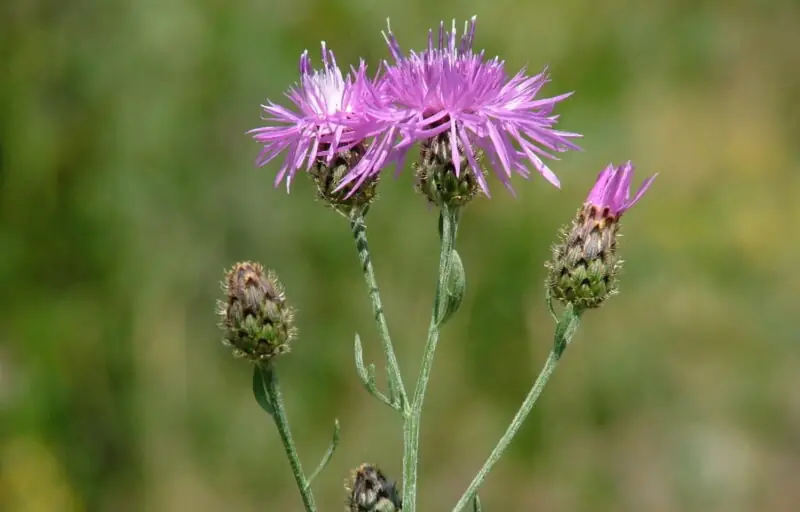
Spotted knapweed, or Centaurea stoebe, is a tough weed that can take over disturbed areas like roadsides, pastures, and fields. The plant has purple-pink flowers that bloom from June to September.
But don’t be fooled by its delicate-looking blooms – this weed is harmful to livestock as it produces toxins in its leaves that can cause digestive problems if ingested.
One interesting thing about spotted knapweed is that it releases chemicals into the soil around it, inhibiting the growth of other plants nearby. This phenomenon is called allelopathy and gives the weed a competitive edge against other species!
Bittersweet Nightshade (Solanum dulcamara)
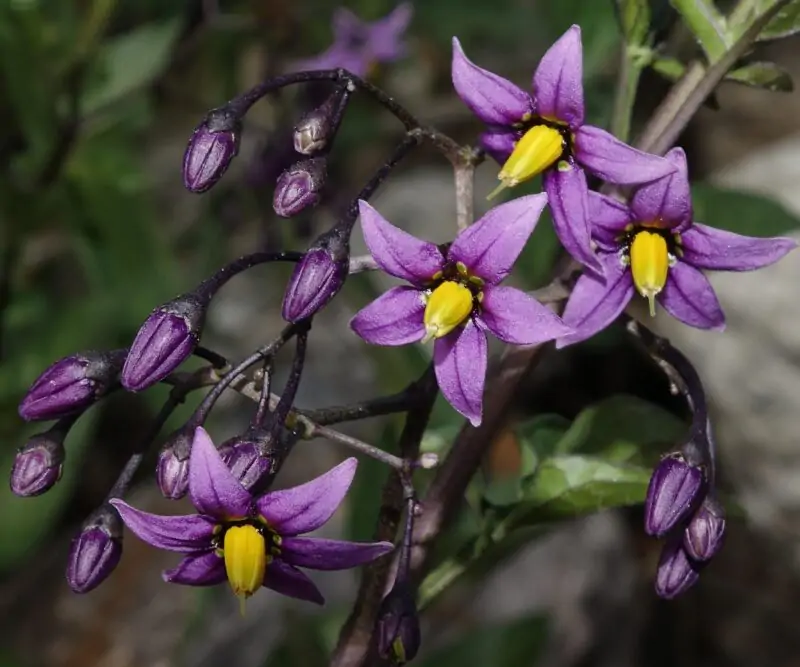
Bittersweet nightshade, or Solanum dulcamara, has pretty purple flowers with yellow centers, but beware – all parts of this plant are poisonous! It’s not something you want growing in your garden where kids or pets could accidentally eat it.
This vine-like plant climbs on trees and fences, producing clusters of small flowers from May to August. Later in summer, red berries appear, which are also toxic when consumed by humans or animals.
Despite being dangerous, bittersweet nightshade was once used for medicinal purposes due to its high levels of alkaloids. Modern medicine now uses derivatives of these compounds as painkillers!
Common Burdock (Arctium minus)
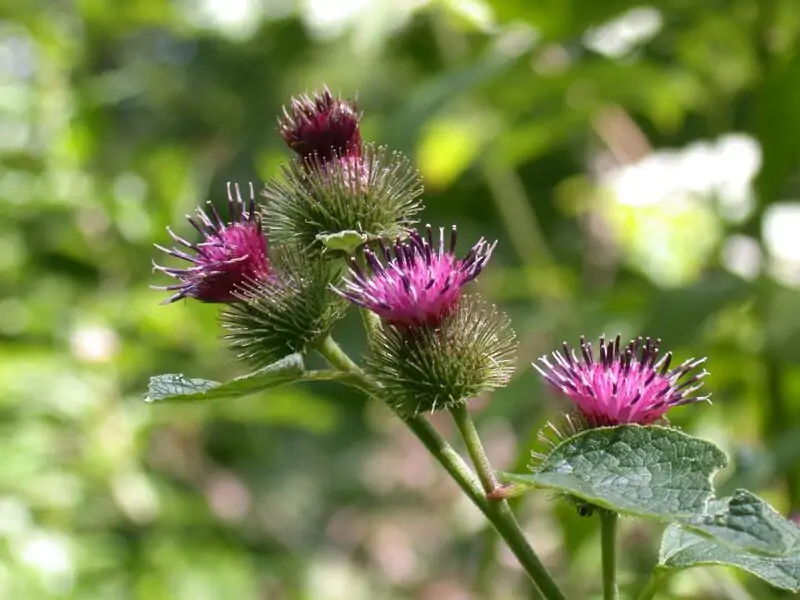
Common burdock, or Arctium minus, isn’t just another pretty face – this invasive weed can grow up to six feet tall! Its spiky purple-pink flower heads bloom during late summer, attracting bees and butterflies. However, if left unchecked, they will turn into burrs covered with hooked bristles that catch onto clothing and animal fur, allowing them to spread easily.
Not only does common burdock make an unsightly mess, but it also causes problems for gardeners due to its long taproot, which makes it difficult to remove by hand. It’s important to take care of this weed before it gets out of control!
Bird Vetch (Vicia cracca)
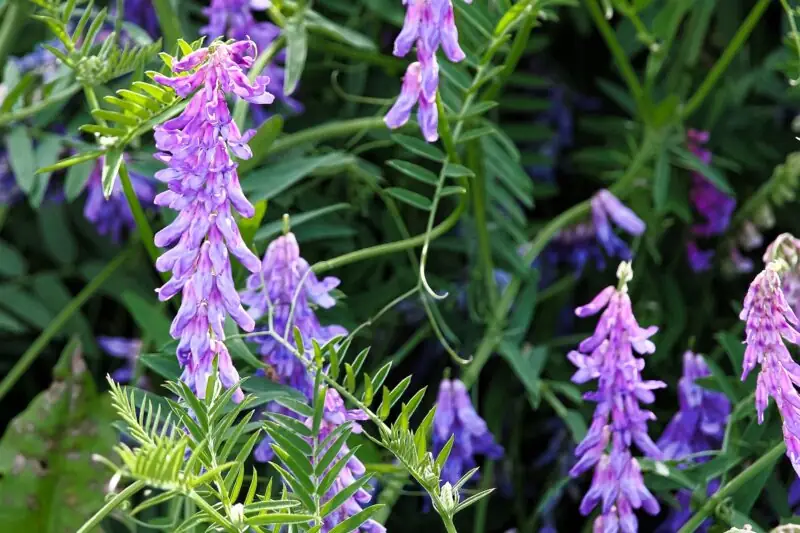
Bird vetch, or Vicia cracca, blooms in mid-summer, producing clusters of purple flowers that attract bees and butterflies. This vine-like plant can grow up to six feet tall and spread quickly through seed dispersal.
Although bird vetch is not considered toxic, the plant can cause problems for farmers as it takes over pastures where livestock graze. It’s best removed from agricultural land before becoming a nuisance.
On the bright side, bird vetch has been used in traditional medicine to treat everything from colds to eczema! Who knew weeds could be so versatile?
Purple Clover (Dalea purpurea)
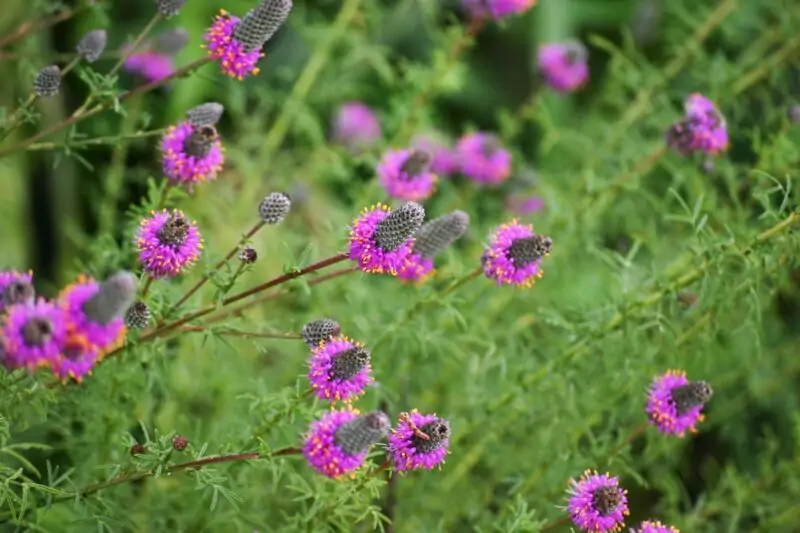
Finally, we have purple clover, or Dalea purpurea – a perennial weed that produces vibrant purple-pink flowers during summer months, attracting pollinators like bees and butterflies!
This low-growing plant spreads through underground rhizomes, making removal by hand difficult but not impossible if caught early enough!
As with most lawn weeds, prevention is key – practice good lawn hygiene like mowing regularly at appropriate heights and keep your soil healthy with proper fertilization techniques, which will help prevent these plants from taking over your yard without requiring chemical herbicides.
Purpletop Verbena (Verbena bonariensis)
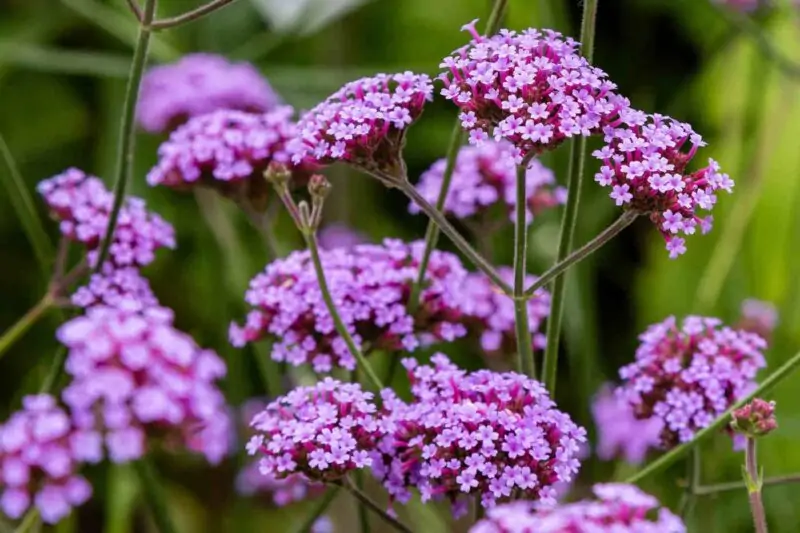
Purpletop verbena, or Verbena bonariensis, is a popular garden plant due to its striking tall stems and purple blooms that appear from summer until fall. This low-maintenance perennial weed provides nectar for pollinators like bees and butterflies.
Native to South America, this weed has naturalized in many parts of the world, including North America, where it can be found growing along roadsides or in disturbed areas.
Although it’s not considered invasive, purpletop verbena can self-seed easily, so make sure you’re prepared for more plants next year if you decide to let this beauty grow in your garden!
How to Identify Weeds with Purple Flowers on Your Lawn
Now that you know some common lawn purple-flowered weeds, it’s time to learn how to identify them yourself! There are several key factors to consider when trying to determine which weed species is growing in your yard:
Examining the Leaves
One of the easiest ways to distinguish different types of weeds is by examining their leaves. Take note of their shape, size, color, and texture. Some leaves may be smooth while others are hairy or prickly.
Observing the Flower Structure
Another important factor in identifying weeds with purple flowers is observing the structure of their blooms. Are they clustered together or spread out along a stem? What do the petals look like? Do they have any distinctive markings or shapes?
Noting the Growth Habit
Different weed species grow in varying patterns – some may spread out horizontally while others grow upright like stalks. Observe whether your weed has sprawling stems or grows straight up from its base.
Considering the Season
Finally, take into account the time of year when identifying lawn weeds with purple flowers. Some plants only bloom during certain seasons, while others thrive year-round.
By taking these factors into consideration and doing a bit of research online or using identification guides specific to your region, you will be able to recognize most common lawn pests quickly!
Common Purple Lawn Weed Control Methods
Once you’ve identified the weeds with purple flowers in your lawn, it’s time to take action and start controlling them. Here are some common methods for getting rid of these pesky plants:
Hand Pulling
Hand pulling is a simple but effective method for removing small patches of weeds. Simply grab the weed by its base and pull upward, making sure to remove all roots.
Herbicides
Herbicides can be an effective way to control larger infestations of lawn weeds with purple flowers. However, it’s important to choose the right product for your specific weed species and follow all safety instructions carefully.
Lawn Care Practices
Maintaining a healthy lawn through regular mowing, fertilizing, watering properly, and aerating can help prevent weed growth in the first place.
Biological Control
Biological control involves introducing natural predators or parasites that feed on specific types of invasive plant species. This method should only be used under professional guidance as it may harm native flora too.
By using one (or several) of the approaches mentioned above, you can manage those unruly plants and prevent them from damaging your yard!
Are Some Weeds with Purple Flowers Beneficial?
It might surprise you that some weeds with purple flowers have positive attributes! For example:
Providing Habitat for Wildlife
Weeds like wild violets provide food sources and habitats for butterflies and bees, while other pests use their stems as housing structures.
Medicinal Properties
Many medicinal treatments incorporate certain herbs like selfheal or heal-all that contain beneficial chemicals providing relief from ailments such as headaches or digestive issues.
Edible Weeds with Purple Flowers
Several edible herbs like violet woodsorrel can be added to salads or other dishes, adding nutritional value and variety!
Purple Flower Weed FAQs
Here are answers to some frequently asked questions about identifying common lawn-style pests:
Canada thistle, creeping thistle, musk thistle, and black nightshade are all common tall weeds with purple flowers.
It’s impossible to say without examining your lawn. Refer to our guide on identifying lawn weeds or consult a professional.
Some of the most concerning pests include bittersweet nightshade, which is toxic if eaten; spotted knapweed, an aggressive invasive species that can take over large areas; and burdock, which produces those pesky burrs that stick to clothing and pet fur.
Yes! Some species like selfheal or heal-all and violet woodsorrel can make great additions for their culinary uses and attractive foliage/features!
Conclusion
Identifying lawn weed infestations takes time, but it’s worth doing as soon as possible before they spread across your property. With this comprehensive guide on common lawn-style pests, you should now have a better understanding of how they look and ways to control them! Remember: Keep pulling, mowing regularly, and trying out natural methods whenever possible. Take care of your grass so it will stay lush and healthy, leaving no space for unwanted weeds with purple flowers.